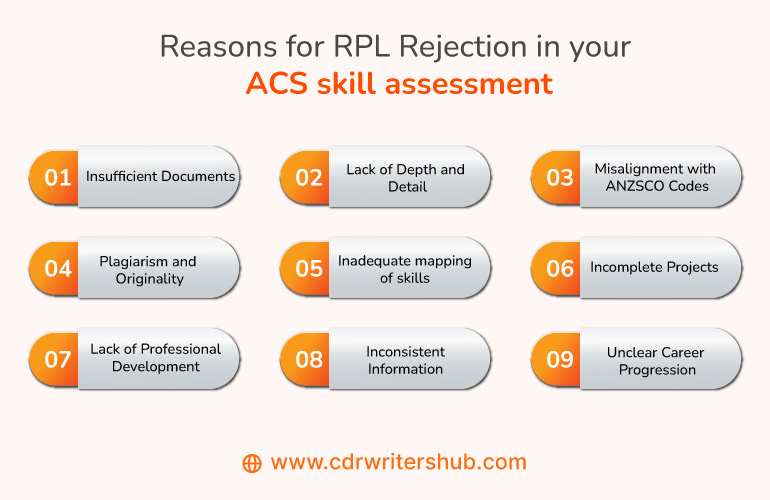What are the reasons for RPL rejection from ACS?

What are the reasons for RPL rejection from ACS?
If you’re a skilled professional in the world of Information and Communication Technology (ICT), chances are you’ve thought about the exciting possibilities Australia offers. It’s a place known for its vibrant job opportunities and exceptional quality of life. But getting there requires understanding a key aspect: the Australian Computer Society (ACS) skills assessment process, especially if you’re considering the Recognition of Prior Learning (RPL) pathway.
With our comprehensive guide, you’ll not only understand how to navigate the ACS skill assessment but also feel confident as you step into a new phase of your career in Australia. So, let’s dive into the world of ACS skill assessment, unravel its details, and reasons for RPL Rejection, and empower you to embrace your career goal of getting permanent residency.
Importance of ACS Skill Assessment
Table of Contents
The ACS skill assessment is important for ICT professionals who want to move to Australia. It works like a gatekeeper, checking the qualifications, skills, and experience of applicants based on ACS standards. This assessment makes sure that applicants have the skills needed to help in Australia’s work and protect the interests of both the professionals and the country.
The ACS offers various pathways for skill assessment, one of which is the Recognition of Prior Learning (RPL) pathway. This pathway caters to professionals lacking formal qualifications but boasting much work experience. The RPL pathway enables them to show their skills through a detailed application that highlights their experiences, roles, responsibilities, and contributions to ICT projects.
Key Components of an RPL Application
When it comes to your RPL application submitted to ACS, think of it as a puzzle with essential pieces that paint a clear picture of your skills and experience:
- Personal Information: Start with your personal information – the basics like your name and contact details. Make sure everything is correct so communication goes forward.
- Employment History: Share your work journey in detail. Mention your roles, what you did, your job titles, and how long you worked in each position.
- Project Descriptions: Don’t forget the projects you’ve been a part of. Give a full description of them – talk about what you did, the tech you used, the problems you tackled, and what you achieved.
- Key Areas of Knowledge: Map your experience to the ACS Key Areas of Knowledge, showcasing your expertise in various domains of ICT.
- Continuing Professional Development: Keeping up with the ever-changing world of ICT is crucial. If you’ve taken any certifications, courses, or training to stay up to date, make sure to highlight them. It shows you’re committed to staying in the know.
Reasons for RPL Rejection in Your ACS Skill Assessment
If there are any mistakes in your RPL report, the ACS won’t accept it. Our RPL Report experts looked into why many RPL reports get turned down. They found that people who don’t follow the rules or don’t know ACS guidelines could have their RPL rejected.
The Australian Computer Society said no to people who didn’t use good projects in their RPL report. But people who got help from RPL report writers were successful. But that doesn’t mean you should give your report to them. To do it right, you need to understand the ACS RPL Report rules.
1. Insufficient Documents
One big reason for RPL rejection is that there’s not enough documentation. The people at the Australian Computer Society (ACS) who assess these applications want strong proof of your work experience. They want to see detailed descriptions of your projects, what you did in your roles, and the technologies you used.
If you don’t give them all the info they need, things can get confusing and unclear about what you’ve actually done. To make sure your application doesn’t get rejected because of this, it’s important to collect and show a clear record of your work history.
2. Lack of Depth and Detail
ACS assessors aim to assess your expertise across various ICT domains. But, if your RPL submission lacks depth and detail in describing your projects, tasks, and the challenges you’ve faced, it may be insufficient to showcase your skills. Only a surface-level overview doesn’t provide the necessary insight into your capabilities.
To avoid RPL rejection, ensure your project descriptions are rich in detail, outlining the specific tasks you’ve undertaken, the technologies you’ve employed, and the outcomes you’ve achieved.
3. Misalignment with ANZSCO Codes
The Australian and New Zealand Standard Classification of Occupations (ANZSCO) codes are like labels that help sort different ICT job roles. If the work experience you mention in your RPL application doesn’t match the ANZSCO code you’ve picked, ACS might reject your submission.
This is because there’s a difference between what you say you’ve done and what the code needs. It’s important to pick the right code that fits your skills so that you don’t end up with a mismatch and a possible RPL rejection.
4. Plagiarism and Originality
ACS places significant emphasis on the authenticity of your RPL submission. Instances of plagiarism or copied content from online sources can raise red flags and lead to immediate RPL rejection. Your RPL application should reflect your own unique experiences, challenges, and solutions. It’s vital to maintain originality in your application to avoid falling into the trap of copied content and potential RPL rejection.
5. Inadequate mapping of skills
Mapping your skills and experience to the ACS Key Areas of Knowledge can be a challenging try. Failure to show how your work aligns with these key areas can lead to rejection. The ACS assessors need a clear understanding of how your skills match their criteria. To prevent RPL rejection due to inadequate skill mapping, ensure that your RPL submission showcases your skill in the essential knowledge domains.
6. Incomplete Projects
ACS assessors prefer to see completed projects within your RPL application. Focusing on ongoing or incomplete projects can raise doubts about your ability to see a project through to its conclusion. Highlighting your experience with projects from start to finish not only illustrates your commitment but also showcases your capacity to manage tasks.
7. Lack of Professional Development
The world of technology get known for its speedy changes, and ACS assessors expect applicants to keep up with the latest trends and technologies. If your RPL submission doesn’t show that you’re continuing to learn and grow, it might raise concerns about how up-to-date your skills are.
To prevent your application from getting rejected because of this, highlight any training, certifications, or courses you’ve taken. This proves your dedication to staying current in the field.
8. Inconsistent Information
When the information you provide in different parts of your RPL doesn’t match up, it can make assessors doubt the accuracy of your application. Having a clear and consistent story is crucial to ensure that assessors understand your skills and experience. Before submitting, make sure to go through your application to ensure that all the details are consistent and accurate.
9. Unclear Career Progression
ACS assessors look for a clear and logical path in your career that shows how you’ve grown in responsibilities and skills. If your RPL application doesn’t show this progression, it might seem like there’s no clear storyline in your professional journey. To avoid RPL rejection, highlight your career journey, emphasizing how each role and project has contributed to your growth.
Guidelines to Ensure a Successful ACS RPL Application
If you’re in the tech field and planning to move to Australia, the Australian Computer Society (ACS) will assess your skills and qualifications. Even if you don’t have formal degrees, you can prove your abilities through the Recognition of Prior Learning (RPL) pathway using your work experience and projects.
To ensure your RPL application doesn’t get rejected, stick to these straightforward guidelines for a smooth assessment process.
1. Comprehensive Documentation
Think of your RPL application as a puzzle, and the documents you collect are the pieces that make it complete. These documents checklist include detailed project descriptions, explanations of your roles and responsibilities, and the technologies you’ve worked with. It’s like building a solid foundation for your case.
By putting all these pieces together, you give ACS assessors a full view of your skills and experiences. This makes it easier for them to understand your capabilities.
2. Detailed Project Descriptions
Imagine your RPL application as a canvas waiting to get painted, and your projects are the vibrant brushstrokes that bring it to life. Provide all the juicy details about your projects – the hurdles you faced, the creative solutions you came up with, the technologies you used, and the exact contributions you made to achieve successful results.
By diving deep into these details, you’re giving ACS assessors a clear picture of your skills and the value you bring. This deeper understanding can go a long way in impressing them.
3. Accurate ANZSCO Code
Think of it like a puzzle – a piece needs to fit to finish the picture. Just like that, the ANZSCO code you choose should match your experience. Researching and picking the right code that fits your skills is super important for a successful assessment. The right code helps ACS understand what you’re good at, making things clear and avoiding confusion.
4. Original Content
Originality is the name of the game when it comes to crafting your RPL submission. Imagine your application as a unique story that only you can tell. Craft an original and authentic narrative, steering clear of using plagiarized content from sample RPLs or online sources. ACS values authenticity and wants to hear about your real experiences, not a rehearsed script.
5. Mapping to Key Areas
as a map helps you navigate unfamiliar terrain, mapping your experiences to the ACS Key Areas of Knowledge guides assessors in understanding your skill across various domains. Indicating how your skills align with these key areas is essential. Imagine drawing lines connecting your experience to each relevant area – this visual connection is what ACS assessors need to see.
6. Highlight Completed Projects
ACS assessors appreciate seeing the finish line – that’s why completed projects hold significant value. By focusing on projects you’ve seen through to completion, you showcase your ability to manage tasks from beginning to end. It’s like presenting a story with a satisfying conclusion, reflecting your dedication and project management skills.
7. Emphasize Professional Development
In the ever-evolving landscape of ICT, showcasing your commitment to continuous learning is crucial. Just as a plant needs water to grow, your skills need nourishment through professional development. Display this commitment by including relevant certifications, courses, and training you’ve undertaken. ACS wants to see that you’re not only keeping up but also thriving in the dynamic tech world.
8. Consistency in Information
Imagine your RPL application as a quilt – every piece of information needs to fit together. Discrepancies or inconsistencies across different sections can cast doubt on the accuracy of your application. To create a coherent and compelling narrative, ensure that all details align, providing a consistent and accurate representation of your skills and experiences.
9. Show Career Progression
ACS assessors appreciate a clear and logical career progression. Think of your career as a journey – each step contributing to your growth in skills and responsibilities. Highlight this journey by presenting a narrative that showcases how you’ve evolved. This clear progression not only showcases your development but also reinforces your readiness for the challenges of the Australian ICT landscape.
Navigating the ACS Dashboard
Applicants can track their progress through the ACS dashboard, referred to as MyACS. This personalized portal allows you to:
- Submit Applications: Start and submit your ACS skill assessment application, including RPL submissions.
- Check Assessment Status: Check the progress of your assessment, ensuring transparency in the process.
- Pay Fees: Process the requisite assessment fees through the dashboard.
- Communicate with ACS: Use the dashboard to correspond with ACS assessors and officials for clarifications or updates.
ACS Skill Assessment Processing Time
One of the concerns often weighing on applicants’ minds is the processing time for ACS skill assessments. The processing time varies depending on the volume of applications received and the complexity of the assessment. While ACS provides estimated processing times on its official website, it’s important to note that these are subject to change.
Conclusion
If you’re an ICT professional dreaming of moving to Australia, the ACS skill assessment process, which includes the RPL report writing pathway, is a big deal. But don’t worry, it’s not as complicated as it might sound. All you need is to pay close attention to details, be real about yourself, and understand what ACS is looking for.
By following the tips in this guide and making your application match your skills, you’ll sail through the ACS skill assessment and open doors to a cool ICT career in Australia. Remember, getting ready well, sticking to the rules, and showing what you’re good at are the keys to winning the ACS skill assessment avoiding RPL rejection, and having an awesome future in Australia.



